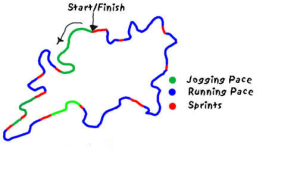Fartlek training is an aerobic training method that requires the intensity to change at random times. Random changes in intensity helps to replicate many sporting environments and specifically helps the bodies cardiovascular system to adapt quickly as intensity changes.
There are various modes of Fartlek training and various methods of changing the intensity. Examples of Fartlek training include:
- running around an oval changing between sprints, jogs and walking at various sections
- outdoor cycling where the surface is not continually flat, requiring intensity changes going up and down hills
- using a cross trainer in the gym and changing the resistance at various intervals etc.
This method of aerobic training allows the athlete to train not just the aerobic systems, but also the anaerobic systems as the higher intensities may move into the anaerobic training zones, and then back into the aerobic zones allowing the body to recover from the higher intensity, before again increasing or decreasing the intensity.
Fartlek training, therefore, helps the body to remove lactic acid, and recover from high intensities that may be required during competition, but can also ensure the athlete continues to perform at a high intensity while recovering. This adapting of the body means that during Fartlek training the athletes heart rate will change constantly with the intensity, as will their respiratory rates, cardiac output and oxygen uptake.
Sports that are most suited to Fartlek training include: AFL, football, rugby codes, netball (particularly centres and wing attack/defence, futile, ice-hockey, gaelic football, lacrosse, and more. Fartlek aerobic training is also covered in Factors Affecting Performance, how does training affect performance?, types of training and training methods, aerobic training.

